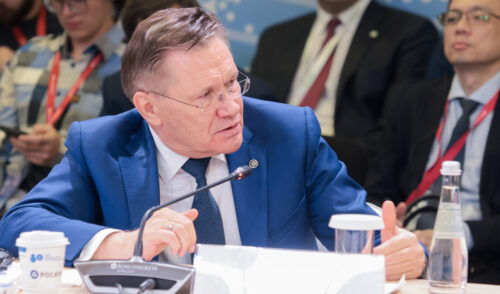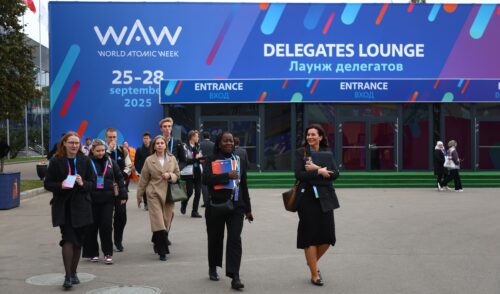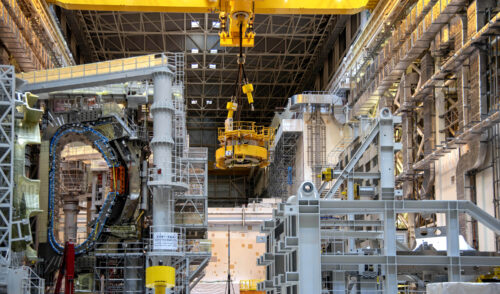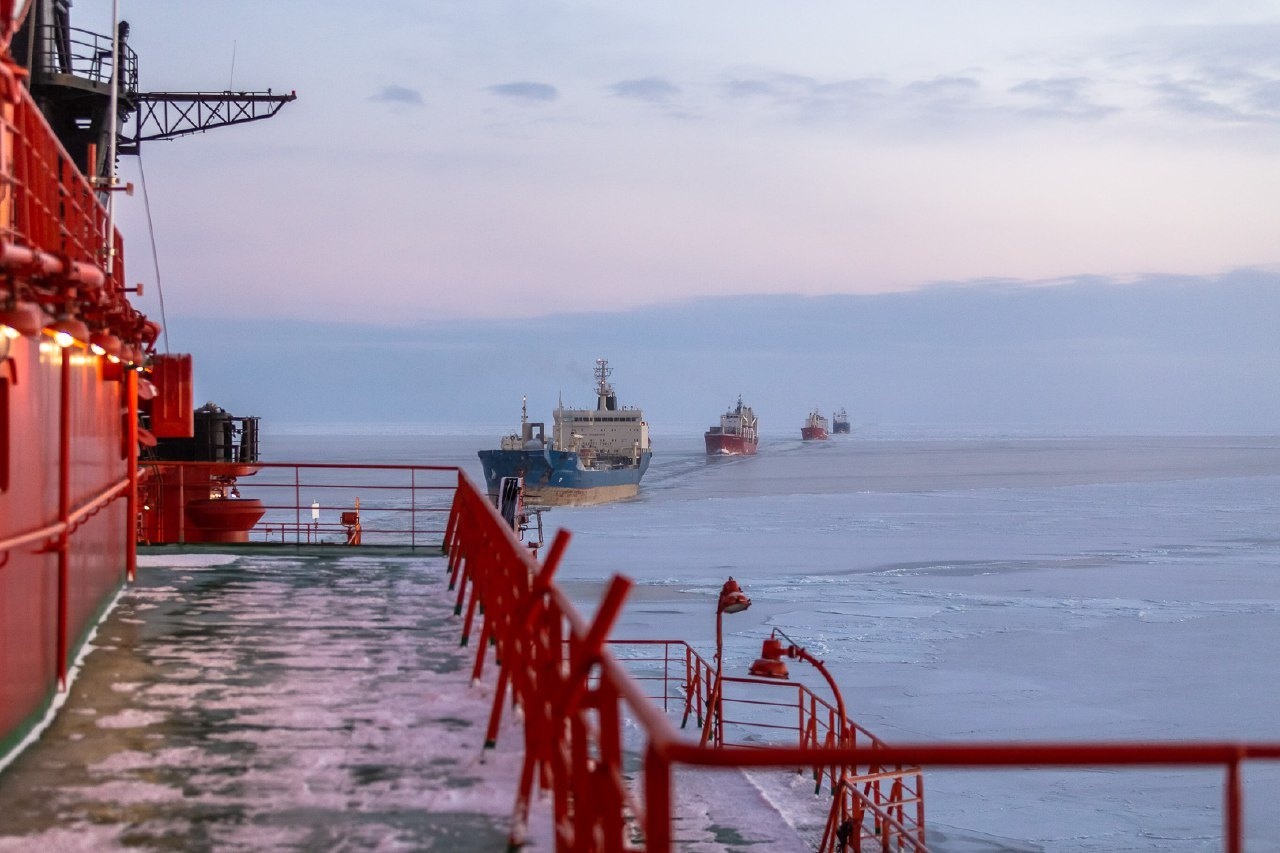
Arctic Motion
back to contentsRosatom is developing international partnerships, Arctic shipbuilding, and infrastructure of the Northern Sea Route (NSR) as the shortest shipping lane between Northern Europe and Asia. These are parts of a broader national strategy for the Arctic expansion.
Promoting freight transport on the Northern Sea Route
In early July, Rosatom and China’s container service operator NewNew Shipping Line launched a new multimodal route, Express NSR 1. A container train left the Bely Rast logistics center near Moscow and headed for the port of Arkhangelsk. The next step is the loading on a container ship and transportation of cargoes via the NSR to the Chinese ports of Shanghai and Ningbo. And in mid-August, the first ship from China on the route Arctic Express No. 1 was solemnly welcomed at the Arkhangelsk Commercial Seaport. Then the cargo went to Moscow and St. Petersburg.
A total of 12 voyages to be made by the end of the year. The length of the route is about 1,200 kilometers by rail and 6,600 nautical miles by sea. “The start of the Arctic Express is a historical event for the Northern Sea Route project. The route will give new impetus to the development of logistics between the two countries and promote trade cooperation,” Ke Jin from NewNew Shipping Line said at the launching ceremony.
The launch of the route is the first step towards delivering on the agreement signed by Rosatom and NewNew Shipping Line at the Saint Petersburg International Economic Forum in June this year. “We receive maximum support in our cooperation with Rosatom. And more importantly, we buy into the idea that the NSR can reduce delivery time, which is the primary goal of any freight transport company,” Fan Yuxin, Chairman of NewNew Shipping Line, said at the forum.
Other freights are running their course, too. In early July, the nuclear-powered icebreaker Vaygach joined three ships near Cape Zhelaniya to escort them eastwards. The ships are carrying oil products and other cargoes to remote Russian communities.
In late July, another ship, Lady D, set on this year’s first government-financed coastal voyage, which follows the route Arkhangelsk — Nakhodka — Murmansk with calls at Korsakov, Pevek, Magadan and Petropavlovsk-Kamchatsky. Lady D will bring fish products from the Far East to Murmansk. In total, three such voyages will be made this year, as many as last year.
A coaster line with dispatch dates understandable to shippers, operating between the north-west of Russia and the Far East, makes it possible to deliver cargoes to ports on the NSR route from St. Petersburg to Vladivostok. The geography of voyages is expanding, and this year alone the number of ports has grown from 11 to 14.
Thus, Rosatom is expanding its activities, fulfilling a key task on the Northern Sea Route — to ensure safe cargo transportation.
Rosatom is an operator of the Northern Sea Route infrastructure. Its NSR Directorate includes the NSR Administration, which issues navigation permits and provides information and navigation support to the vessels traveling on the NSR; Atomflot, an operator of nuclear icebreakers escorting ship convoys along the NSR; and the Hydrographic Service, which is engaged in the provision of port infrastructure and dredging operations, thus improving navigation safety and creating new opportunities for the Northern Sea Route traffic.
Rosatom is also developing its own mining projects and small-scale nuclear generation, both onshore and offshore, in the Arctic.
In the international context
Russia is the largest investor in the Arctic. As noted in the Arctic Zone of the Russian Federation: Risks and Development Prospects report by Yakov & Partners consulting firm, Russia’s Arctic Development and National Security Strategy 2035 provides for USD 187 billion to be invested in the region. The key goals and objectives set out in the Strategy envisage the Arctic as a territory of comprehensive social and economic development driven by research, technology and extended infrastructure. They will be achieved through the build-out of the Northern Sea Route, intensification of extraction activities at the oil, gas and metal deposits, and construction of LNG plants.
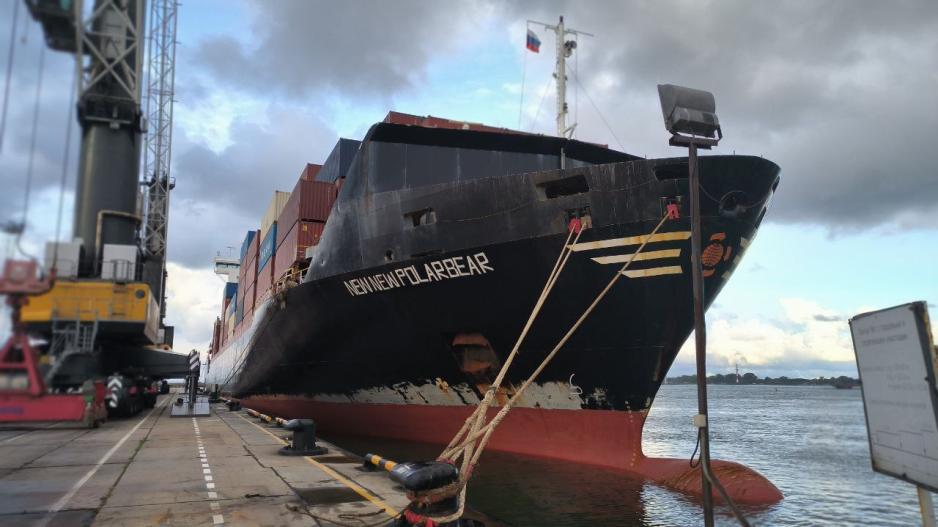
As a comparison, Norway plans to invest USD 97 billion in the Arctic pursuant to its national strategy, with USD 96 billion to be spent by Sweden, USD 73 billion by Canada, and USD 33 billion by the US. Cumulative investments by Finland, Denmark and Iceland total USD 35 billion, the report says.
China is also interested in expanding its footprint in the Arctic. “Combining investment and commercial activities, research and humanitarian projects, contributions to local communities and Arctic governance initiatives, China is systemically strengthening its geopolitical position in the region without confronting the Arctic states,” the report says.
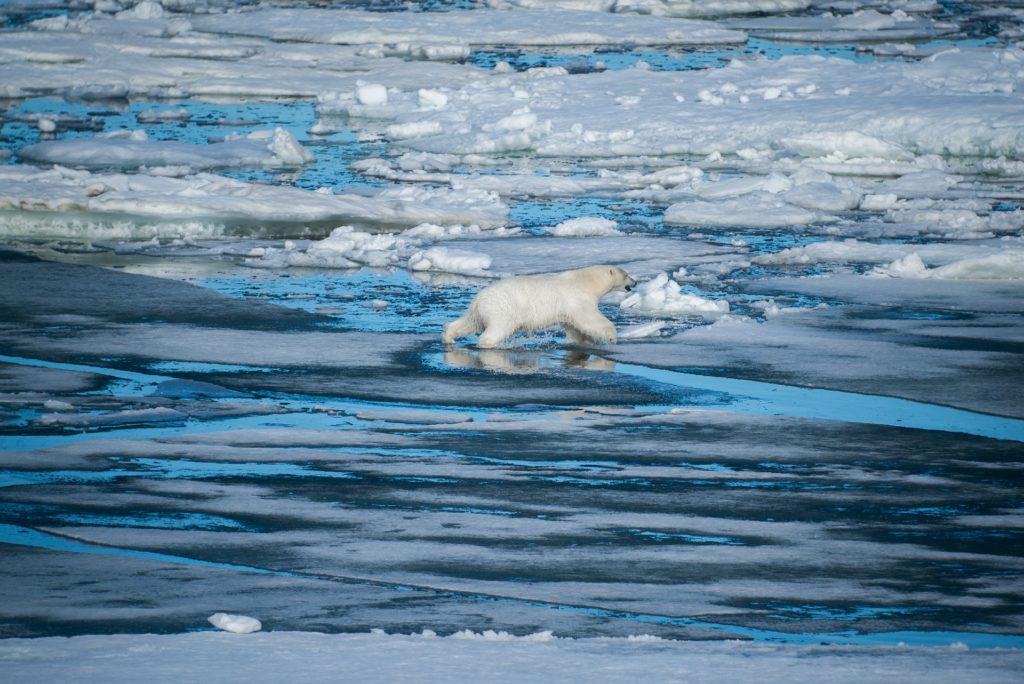
Economic significance of the region
Life in Russia’s Arctic is to a great extent dependent on the development of hydrocarbon and mineral deposits, including iron ore, nickel, diamonds, coal, copper, gold and others. In 2022, the Russian government approved a development plan for the NSR until 2035 with funding of almost 1.8 trillion rubles (USD 19.5 million). The main goals are to ensure reliable and safe transportation of cargoes for residents of the Far North, as well as to create conditions for the implementation of investment projects in the Arctic zone of Russia, according to a comment on the government portal.
The mere possibility of building mineral extraction and processing facilities and exporting their products is inherent in the availability of a developed transportation system. Thus, the efforts made to improve navigation on the Northern Sea Route and partnerships with friendly countries are strategically important for the economic, technological and political sovereignty of the Russian Federation, and also for the development of international trade through the creation and improvement of routes for the delivery of cargoes with shorter deadlines and no security risks. Cargo traffic along the Northern Sea Route is expected to grow to 220 million tons by 2035.
Shipbuilding in the spotlight
Construction of Arctic-class ships is key to the Arctic development. This topic has been repeatedly raised at all major economic conferences, including the Eastern Economic Forum, Saint Petersburg International Economic Forum, Neva Forum, and others. 15 rescue vessels, including tugs and multi-purpose ships, are under construction to ensure safe navigation on the Northern Sea Route. Contracts for the construction of another 30 same-purpose vessels are expected to be signed in the next six years.
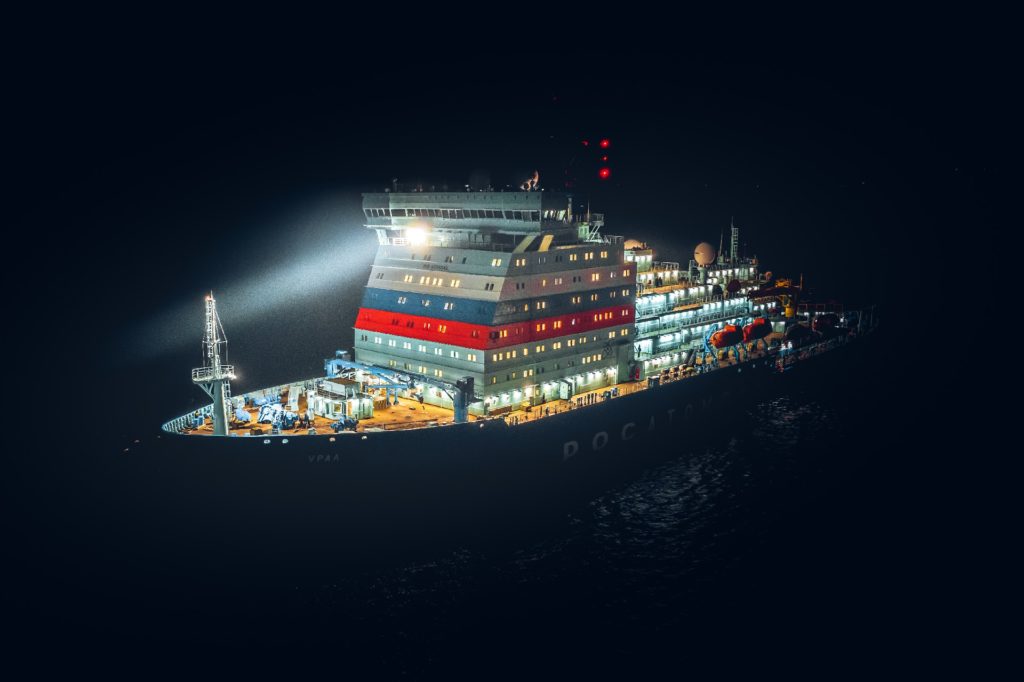
The Zvezda Shipyard in the Russian Far East has already delivered five Aframax oil tankers to customers, with contracts signed to build another 26 tankers of different capacities. The company also plans to build 92 ice-class vessels of various purposes (container carriers, dry bulk carriers, tankers, etc.) by 2037.
It is expected that the government will make a decision by the end of the year to construct a new shipyard (Russia’s North West and Far East are being considered as its optional locations). Much work is also being done to set up production of key vessel systems, with Rosatom playing an important role in this effort.
New partnerships are being formed with international market players. For example, the agreement between Rosatom and NewNew Shipping Line also provides for the establishment of a joint venture to build high-ice-class container ships and manage a container line.
High-ice-class vessels are one of the necessary conditions for the development of the Arctic, faced by both Russia and any other country engaged or planning to engage in the Arctic. Powerful icebreakers are indispensable for safe and reliable navigation in the Arctic Ocean.
With nuclear-powered icebreakers in its fleet, Russia, unlike other countries, boasts a huge advantage. There are seven of them, including three most advanced nuclear icebreakers of the Project 22220 series. These are Arktika, Sibir, and Ural. Another three — Yakutia, Chukotka and Leningrad — are under construction, with the first two in the final stages. Nuclear fuel has already been manufactured for the two reactors of the Yakutia icebreaker, which is expected to be commissioned by the end of 2024. Another icebreaker of the same series, Stalingrad, is planned to be laid down in 2025.
Also under construction is Rossiya, an icebreaker of the Project 10510 (Leader) series, which has an unparalleled ice-breaking capability of over four meters. This is enough to ensure year-round navigation on the Northern Sea Route. Rossiya is expected to be put in operation by the end of 2030.
In general, the combined efforts of those interested in the NSR navigation will ensure progress of the Russian mining projects in the Arctic, improve life in the Arctic communities, provide Russian companies and projects with Russian-made vessels, and turn the Northern Sea Route into a customary freight lane and an obvious choice for international trade.
Careful attitude to the Arctic
One of the most important tasks for Rosatom is to preserve the unique ecosystem of the Arctic region. Rosatom, together with the Marine Research Center of Moscow State University, has been conducting environmental monitoring of the NSR water area since 2021. The goal is to monitor the environmental safety of the route and prevent negative environmental impacts. Field research is being conducted in the main port waters of the NSR.
In general, the Northern Sea Route is being transformed into a familiar and understandable international route that ensures the stability of cargo transportation and the stability of the global logistics chain. Along this route, companies from all over the world will be able to transport cargoes quickly, conveniently and safely.


